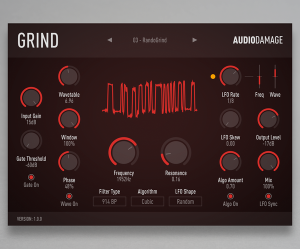Audio Damage is Has released 3 new plug in VSTs available directly from their site. New versions of the Delay Plug in “Dubstation 2″, Reverb Plug in ” EOS 2 ” and the all new waveshaping distortion “Grind” are now available.
EOS 2 consists of four high-quality custom-designed reverb algorithms, made with the modern production environment in mind. Three different plate simulators and Audio Damage’s own Superhall algorithm give you a broad palette of reverb, and the easy-to-understand interface makes adjusting the algorithms to suit your track incredibly simple.

From the Audio damage site:
The original dub delay plugin and still the best! Dubstation 2 takes our most popular product and adds a whole raft of new features, including a dual mode for separate control over the left and right delay times, ping-pong, a new feedback saturation algorithm, and an LFO. Along with an all-new procedural and Retina-friendly user interface and (FINALLY!) ProTools compatibility, this represents a major leap forward for one of our signature products.
All those bells and whistles aside, the heart of Dubstation is our painstaking bucket-brigade delay model. Often imitated, but never duplicated, Dubstation has been the go-to plugin for that sound for over a decade, used in thousands of commercial productions, and with good reason. With the addition of the LFO and saturation controls, Dubstation has moved in to the realm of tape delay emulation as well, and is a sonic Swiss Army knife for delay. 
from the AD site:
A true powerhouse of audio warfare, Grind puts the “damage” in Audio Damage. From subtle tube-style saturation to full-on mangled wavetable distortion, Grind is a Swiss Army Knife of sound design.
Grind consists of three main blocks: wavetable lookup, in to algorithmic saturation/distortion/, and finally to a multi-mode filter. The wavetable module uses the amplitude of the incoming signal to replace the sample with one from 15 different linearly-interpolated wavetables, chosen for their mangling potential. Window size and phase controls provide further tone-shaping possibilities.
The next stop is the algorithm module, with eleven different distortion and saturation algorithms, from simple soft-knee saturation on up to full on sine warping.
After this, the signal passes through a multi-mode filter stage, with eleven different filter models to choose from, including “vintage digital” versions from the early days of plugin development, on up to our modern analog-modeled MS20-style lowpass and highpass synth filters. A tempo-synced LFO provides motion for the filter frequency, and a final stage of soft clipping and DC filtering tames the output.
Make no mistake: this is not a subtle, polite tool. With careful tuning of the provided presets, it can be tamed to normal filtering and saturation duties, but on the whole, it is a noisy, snorting beast of a plug-in, and is happiest with Full Metal audio destruction. 
OK enough with the AD copy. I have had some time with all three of these (I even created a group of presets for Dubstation 2). I can say these are a really nice step forward in the Audio Damage line up. The UI is really impoved on these (Grind and EOS2 have some killer front end graphics to help understand whats going on).
Grind really impressed me in its filter types as well as how the distortions can take a plain sound and add a ton of movement and character. Similar to the Eurorack module Shapes also from Audio Damage, Grind lets you sequence lookup tables and waveshaping wavetables… very freaking cool.
tempo syncing the waveshaping and filter frequency changes is a joy.
Dubstation 2 is a very straight foward BBD sounding delay that will let you just easily get that dub delay you are after without a cluttered interface.
EOS 2 is just a joy to look at and hear. I’ve been using this to create gorgeous synth pads and basically create environments for my instruments to breathe in.

